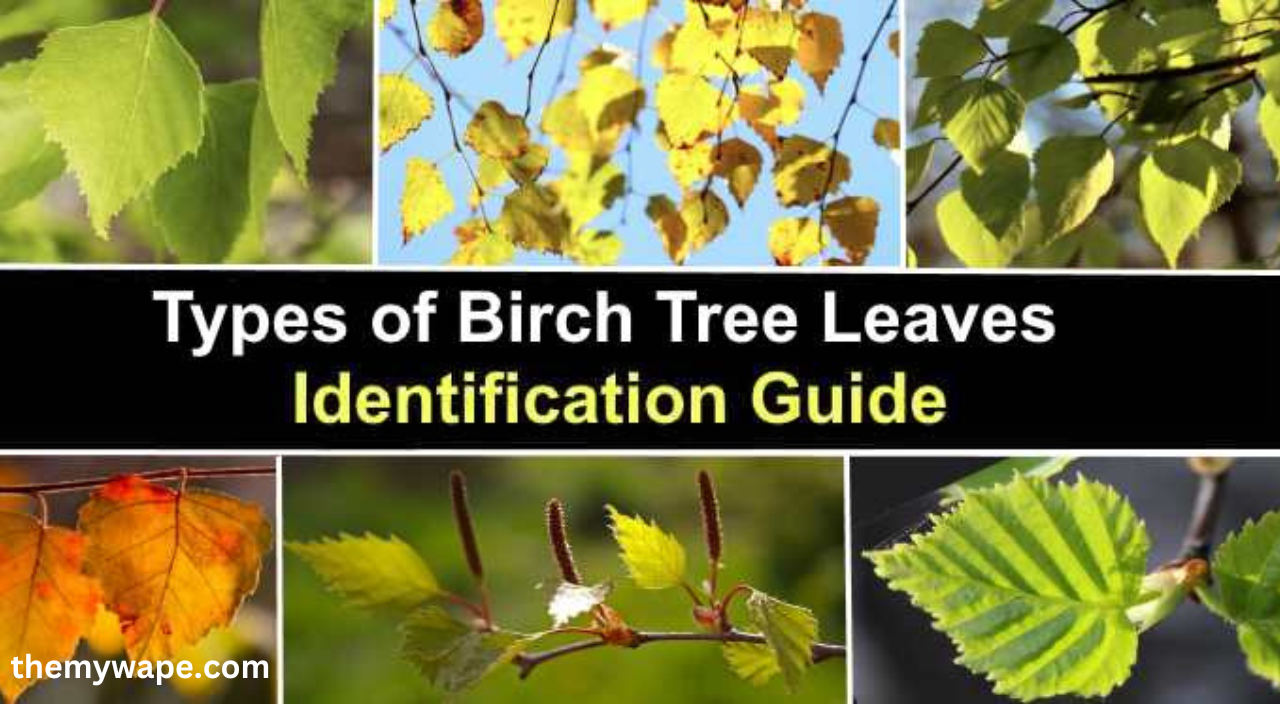Introduction
Birch tree leaves are a remarkable feature of the birch tree, known for their unique appearance, numerous benefits, and various uses. Birch trees, belonging to the genus Betula, are widespread across the Northern Hemisphere, particularly in temperate and boreal climates. Their leaves are not only aesthetically pleasing but also hold significant cultural, medicinal, and ecological value. In this comprehensive guide, we will explore everything there is to know about birch tree leaves, from their characteristics and uses to their benefits and frequently asked questions.
Table of Contents
Characteristics of Birch Tree Leaves
These leaves are usually of small to medium size and often have a triangular or ovate form. Typically, these leaves are small to medium-sized, with a triangular or ovate shape and serrated edges. The leaves have a vibrant green color during the growing season, which turns into stunning shades of yellow in the fall. The leaves are arranged alternately on the branches, which adds to the tree’s delicate and airy appearance.
The surface of birch tree leaves is smooth, and they have a glossy finish. The veins on the leaves are prominent, creating a patterned look that is both intricate and attractive. These characteristics make birch tree leaves a favorite among landscapers and gardeners for adding a touch of elegance to gardens and natural spaces.
Types of Birch Trees and Their Leaves
There are several species of birch trees, each with its own unique leaf characteristics. Among the most frequently encountered species are:
White Birch (Betula papyrifera)
Known for its paper-like bark, the white birch has leaves that are ovate with a pointed tip and serrated edges. The leaves are bright green in the summer and turn golden-yellow in the fall.
Silver Birch (Betula pendula):
This species is characterized by its graceful, drooping branches. The leaves are triangular with double serration along the edges. They are bright green and turn yellow in the autumn.
River Birch (Betula nigra):
River birch leaves are rhombic to ovate, with a slightly rough texture. They are green during the growing season and turn yellow or orange in the fall.
Yellow Birch (Betula alleghaniensis):
The leaves of the yellow birch are elliptical and finely serrated. They are bright green and transition to yellow in the autumn.
Understanding the differences between the leaves of various birch species can help in identifying the trees and knowing which species is best suited for your needs, whether for landscaping or medicinal purposes.
Medical Uses of Birch Tree Leaves
Birch tree leaves have a long history of use in traditional medicine, especially across Europe and Asia, where they’ve been utilized for centuries. The leaves are known for their diuretic, antiinflammatory, and detoxifying properties. Here are some common medicinal uses of birch tree leaves:
Diuretic: Birch tree leaves are often used in herbal teas to promote urination and help the body eliminate excess fluids. This can be beneficial for those suffering from conditions like edema or high blood pressure.
Anti-inflammatory: The leaves contain compounds that help reduce inflammation, making them useful in treating conditions such as arthritis and rheumatism.
Detoxification: Birch leaves are believed to aid in detoxifying the liver and kidneys, promoting overall health and wellness.
Skin Care: The anti-inflammatory and astringent properties of birch tree leaves make them useful in treating skin conditions such as eczema, psoriasis, and acne.
Birch tree leaves in traditional remedies
In addition to their medicinal uses, birch tree leaves have been used in various traditional remedies. “In certain cultures, birch leaves are utilized to create poultices that help in healing wounds and sores.” The leaves are also used in baths to soothe irritated skin and relieve muscle pain.
In Scandinavian countries, birch leaves are used in the traditional practice of “whisking” during sauna sessions. Birch leaf bundles are softly brushed against the skin to boost blood flow and remove dead skin cells.
Culinary uses of Birch tree leaves
While not as common as other culinary herbs, birch tree leaves are occasionally used in cooking and beverages. The young leaves, in particular, have a mild, slightly bitter taste that can add a unique flavor to salads, soups, and teas. Birch leaf tea is a popular beverage in some cultures, known for its refreshing taste and health benefits.
Birch Tree Leaves in Crafting and Art
Birch tree leaves are also used in various crafting and artistic endeavors. You can press and dry leaves to craft stunning, nature-inspired decorations for greeting cards, scrapbooks, or home décor.
The intricate vein patterns and vibrant colors of the leaves make them a popular choice for nature-inspired art projects.
Environmental benefits of Birch Tree Leaves
Birch trees and their leaves play an important role in the environment. The leaves contribute to the overall health of the ecosystem by providing food and habitat for various wildlife species. In particular, birch tree leaves are a food source for many insects, which in turn support birds and other animals.
The leaves also play a role in improving soil quality. When birch leaves fall to the ground and decompose, they add organic matter to the soil, enhancing its fertility and structure. This is especially beneficial in forested areas, where healthy soil is crucial for the growth and sustainability of plant life.
Aesthetic and landscaping benefits
One of the most noticeable benefits of birch tree leaves is their aesthetic appeal. The delicate, airy appearance of birch leaves makes them a popular choice for landscaping and garden design. The vibrant green color of the leaves during the growing season, followed by the golden hues in the fall, adds seasonal interest to any landscape.
Birch trees are often used as ornamental trees in gardens, parks, and urban areas due to their attractive foliage and overall beauty. The leaves, with their distinct shape and texture, contribute significantly to the tree’s ornamental value.
Health benefits of Birch tree leaves
The health benefits of birch tree leaves extend beyond their medicinal uses. Regular consumption of birch leaf tea or supplements can support overall health and wellness. The detoxifying properties of the leaves can help cleanse the body of toxins, while their diuretic effect can assist in maintaining healthy kidney function.
The anti-inflammatory properties of birch leaves can also be beneficial for those suffering from chronic inflammatory conditions. Additionally, the leaves contain antioxidants, which can help protect the body from oxidative stress and reduce the risk of chronic diseases.
Conclusion
Birch tree leaves are a fascinating and versatile natural resource, with a wide range of uses and benefits. From their unique appearance and ecological significance to their medicinal properties and cultural importance, birch tree leaves are truly remarkable. Whether you are interested in using birch leaves for health purposes, crafting, or simply appreciating their beauty, this guide provides all the information you need to make the most of this natural wonder.
With proper care and knowledge, birch tree leaves can be a valuable addition to your life, offering both practical and aesthetic benefits. As you explore the many uses of birch tree leaves, you will discover the rich history and tradition behind this humble yet powerful component of the tree.
Maximizing the SEO Impact of This Article
To ensure that this article ranks highly on Google, it is important to focus on several key SEO strategies:
Keyword Optimization:
The primary keyword “birch tree leaves” has been used consistently throughout the article to maximize its visibility in search engines.
High-Quality Content:
The article provides valuable and informative content that meets the needs of readers searching for information on birch tree leaves.
Internal and External Links:
To improve SEO, consider adding internal links to other related articles on your website, as well as external links to reputable sources for additional information on birch tree leaves.
Mobile Optimization:
Ensure that the article is optimized for mobile devices, as many users access content via smartphones and tablets.
User Engagement:
Encourage readers to leave comments, ask questions, and share the article on social media to increase its reach and engagement.
By following these strategies, this article on birch tree leaves can achieve a high ranking on Google and attract a wide audience interested in this fascinating topic.
FAQs about Birch Tree Leaves
Are birch tree leaves safe to consume?
Yes, birch tree leaves are generally safe to consume when used in moderation. They are frequently utilized in herbal infusions and dietary supplements. However, it is important to consult with a healthcare provider before using birch leaves for medicinal purposes, especially if you have any underlying health conditions or are pregnant.
How can I use birch tree leaves in my daily routine?
Birch tree leaves can be incorporated into your daily routine in various ways. You can brew birch leaf tea, use the leaves in skincare treatments, or even add them to your bath for a relaxing soak. Additionally, dried birch leaves can be used in crafting projects or as natural decorations in your home.
Where can I find birch tree leaves?
Birch tree leaves can be found in the wild, particularly in temperate and boreal forests. If you do not have access to birch trees, you can purchase dried birch leaves from herbal stores or online retailers. Make sure to source leaves that are free from pesticides and other chemicals.
What are the best ways to preserve birch tree leaves?
To preserve birch tree leaves, you can dry them by pressing them between the pages of a book or using a flower press. Once dried, the leaves can be stored in an airtight container away from direct sunlight. Dried leaves can be used for crafting, decoration, or making tea.
Can birch tree leaves be used for making essential oils?
Yes, birch tree leaves can be used to make essential oils, although the process is complex and requires specialized equipment. Birch leaf essential oil is known for its anti-inflammatory and analgesic properties and is used in aromatherapy and massage therapy.
You can see the latest updates on : MyWape



